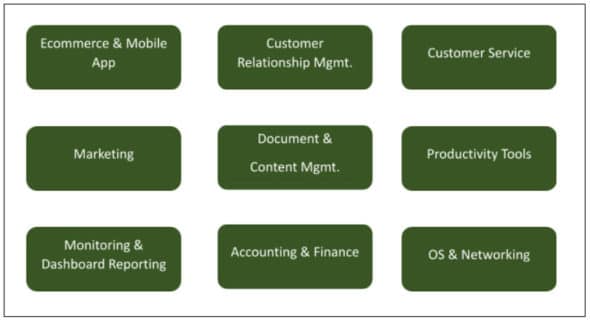Organisations can today use open source software to scale applications and platforms with true agility. There is a range of open source software available to build an organisation from the ground up in a greenfield project.
Greenfield technology implementation refers to building an organisation from scratch, without modernisation or transformation of legacy platforms. Organisations of all sizes are seriously considering greenfield projects after disappointing attempts at brownfield technology implementations that focus on advancing the existing technology landscape little by little. Limited success in modernisation of existing platforms or transformation initiatives has given an impetus to greenfield technology.
Design and architecture play a key role in greenfield implementation. Even though there is no baggage of legacy technology or dated processes holding one back, a new path ahead poses its own risks. To address the concerns head on, one needs to set an overall technology strategy, and define what is fit-for-purpose and fit-for-use across each business function of the organisation to enable the right selection of open source software and platforms.
We know that open source software (OSS) is software that’s released with source code and is licensed, with copyright holders granting the rights to use, change and distribute it to anyone for any purpose. But things are not so simple! Commercial software providers enter the OSS space by releasing early versions of their software for free so that open source enthusiasts can improve it. They keep minimal functioning software for free and market it heavily. They end up confusing developers and organisations, who think they have adopted OSS based application development and give into the ease-of-use hype, but end up paying large sums of licensing fees down the road. Rewriting the application to get out of using the software takes time and money, which most organisations don’t have when they are growing. This is exactly why there should be a focus on design and architecture while selecting the right open source platform, software, and tools in developing applications from the ground up.

Business functions of an organisation
The first step in developing technology strategy is to understand the business functions of the organisation. Once the functions are broken down, the listing and consolidation of the core technical capabilities of competitors will provide a holistic view of what’s needed to get a tech organisation up and running.
A typical organisation consists of many business functions; however, many of these do not need software development. One needs to evaluate if a business function will act as a core service offering or is part of an administrative function. As an example, HR and payroll functions can be outsourced from a technology perspective for significantly lower cost as compared to developing in-house software applications.
Nine blocks of core business functions have been identified where typical organisations like to have all or some level of in-house application development. Table 1 looks at each business function for its core capability and the OSS options for it.
| Business function | Core capability | Open source software(s) |
| E-commerce and mobile app |
Online shopping portal on the Web and on mobile devices working across multiple popular browsers and mobile operating systems | Open Cart, WooCommerce, Zen Cart, Shuup, Ubercart, Spree Commerce. PhoneGap, Flutter, Ionic, BuildFire |
| Customer relationship management | Managing customer information and interactions across all touch points | SuiteCRM, openCRX, EspoCRM, vTiger, Zurmo |
| Customer service | Customer support, request tracking and management | Bugzilla, Helpy, osTicket |
| Marketing | Promoting and selling products and services using emails and campaigns, and generating leads with tracking | Geary, Mautic, OpenEMM, Thunderbird |
| Document and content management | Website and portals for internal use, customers, investors, etc; Documents management and file sharing | WordPress, Drupal, Joomla, OpenKM, 7Zip, WinSCP, FileZilla, FireFTP |
| Productivity tools | Creating text documents, presentations, spreadsheets | Apache OpenOffice, LibreOffice |
| Monitoring and dashboard reporting | Tools to collect, analyse and report data, and develop visualisation charts with dashboards and notifications | Graphana, Datawrapper, Charted, Draw.io, D3 |
| Accounting and finance | Managing resources and assets, order and invoice management, compliance reporting | Apache OFBiz, ERPNext, Tryton, GNU Cash, OpenBravo, GanttProject |
| Operating system (OS) and networking | Platform to run applications and connect across applications, tools and end-point devices | Linux, Ubuntu, Nagios |
Table 1
Most organisations have some exposure to open source software, including that which is sold commercially. Today, there is a range of open source software to choose from to build every desired business function of the organisation. As long as one is willing to take the time in understanding the requirements, there is some open source software readily available to get started with greenfield technology implementation.















































































